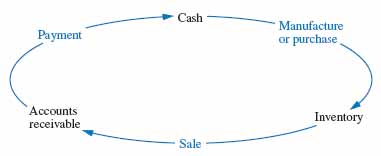THE CURRENT ASSET CLASSIFICATION
Current assets are so named because they are intended to be converted to cash (or consumed) in the near future. The exact definition of the near future is subjective, so the accounting profession has provided guidelines. According to professional standards, a current asset is defined as any asset that is intended to be converted into cash within one year or the company's operating cycle, whichever is longer.1 As illustrated in Figure 6-1, a company's operating cycle is the time it takes the company to convert its cash to inventory (to purchase or manufacture inventory), sell the inventory, and collect cash from the sale. In other words, the operating cycle is the time required for a company to go through all the required phases of the production and sales process.
FIGURE 6-1 The operating cycle

1. “Current Assets and Current Liabilities,” Accounting Research Bulletin No. 43, Restatement and Revision of Accounting Research Bulletin (New York: American Institute of Accountants, 1953), Chapter 3A.
As the definition of current assets states, if the operating cycle is longer than one year, it serves as the time period for current assets. Companies with different operating cycles therefore use different time periods to define current assets. Compare, for example, the relatively short operating cycles of grocery chains like Safeway, Kroger, and Lucky Stores ...
Get Financial Accounting: In an Economic Context now with the O’Reilly learning platform.
O’Reilly members experience books, live events, courses curated by job role, and more from O’Reilly and nearly 200 top publishers.

